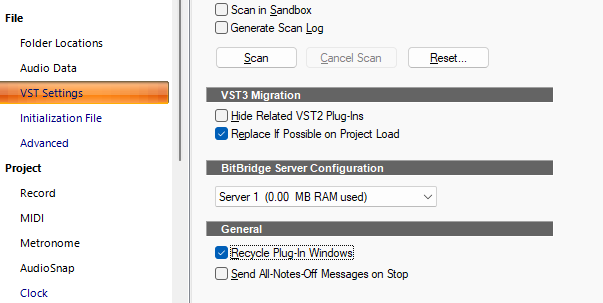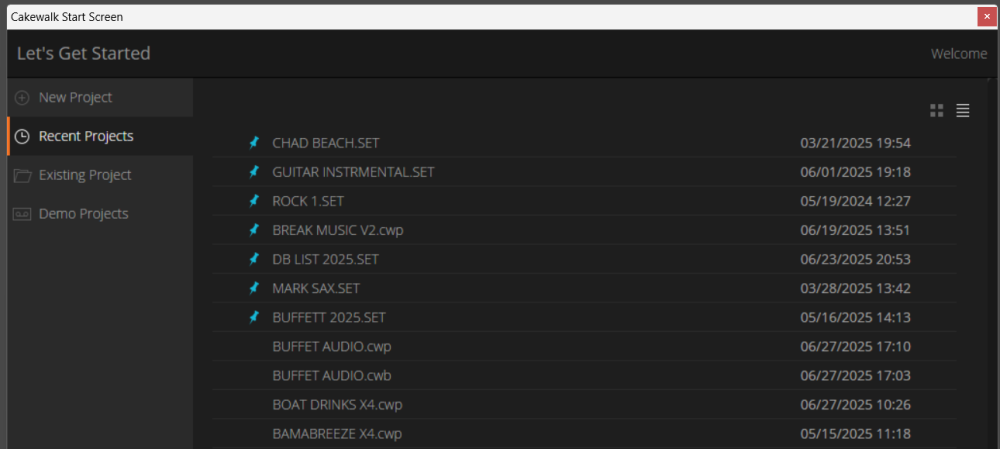-
Posts
5,391 -
Joined
-
Last visited
-
Days Won
95
Posts posted by Noel Borthwick
-
-
Just now, Milton Sica said:
I'll try to explain better what's happening in my installation.
I inserted 2 plugins and, after opening them, I positioned them where I wanted.
If I close any of them and open them again, instead of them keeping the position on the screen where they were closed, they open in the position of the last plugin that remained or was open.
Yes and that has been the behavior for decades. It's nothing to do with this version of Sonar.
-
 1
1
-
-
Read the official FAQ at the bottom of this page where everything about Cbb is explained.
https://www.cakewalk.com/sonar
This is not the post to get into that.
-
On 7/1/2025 at 9:07 AM, warrickhale said:
Further to the above I now have access to the paid for version of SONAR with the new features. These I believe are meant to include the Guitar FX plugins associated with THU and I believe there is meant to be backwards compatibility with TH3, the previous version which was available in SONAR before it was acquired by BandLab.
However when I open old projects which contain tracks which include the TH3 plugin SONAR simply says they are missing. Can anyone tell me how I can access the THU plugin with this compatibility please, I cannot see how to do it?
Sonar will automatically replace TH3 with THU when you open projects containing TH3 as long as you have "Replace if possible on project load" checked in VST3 migration as below. Note for this to work, you must have THU installed on the PC.

-
 1
1
-
-
6 hours ago, Simone said:
Sonar crashes all the time for me.
I use Waves plugins and I can't load the projects I was working on on CbB.
If CbB stops working on August the 1st and I can't open my old projects in Sonar I will be stuck in the middle of the production of my new album.
It is unacceptable putting a software on the market in this broken state and forcing people to migrate to it without the necessary testing.
Good job in kicking your long time users away from you for good.If you want help be productive and submit proper problem reports. Sarcastic comments wont help solve your problem.
-
Can you send a sample project that can demonstrate this difference? There are no changes I know of in Sonar that could make it worse.
-
 1
1
-
-
Product center can only monitor products that were installed via product center. If you installed it years ago via a different installer it has no knowledge of it. Its expected behavior.
-
 1
1
-
-
That is quite weird, the reason for no app windows is likely why it crashes.
When it pops the membership screen can youn check in task manager if Sonar is running still?
Also please try unplugging your audio interface and retry.
When it's in that state before clicking continue can you capture a dump file and PM it to me? Hopefully it can show why the app window isnt running.
If you need help on how to capture a dump see this post. -
8 hours ago, GBTBassist said:
Load nag screen that has a time out telling me I have an evaluation copy. I have updated to 2025.06 just in case it was pre free tier but its just the same. Is this normal behaviour?
Yes of course, its intentional. If you are running in the free tier there is a delay on startup and popups when you try and use features that are premium. If you don't want that, take advantage of the promotional price and purchase a membership.
8 hours ago, GBTBassist said:Latency on all controls - there is a small but significant delay in changing any setting which means I am constantly having to reset fader/knobs on the DAW as well as plugins as i overshoot or undershoot where I want to be. I have tried with/without spectrum analyzer display per track just in case that was the cause but it's just the same.
This is very likely to be something specific to your project or the presence of control surfaces possibly. Have you tried this with a new project?
8 hours ago, GBTBassist said:The completely out of character 'File, Open' dialogue box which seems to be a windows 7 style, all square and ignoring colour preference of the main app. Really!!?
File open is a system dialog that we don't want to replace because it has windows defined functionality. Most Windows apps use it.
-
 2
2
-
-
1 hour ago, Milton Sica said:
Yes, is this,
I had understood that the SONAR installation would take advantage of the previous Cakewalk settings
Something I noticed when I unchecked recycling is that it works differently from Cakewalk.
Now, even if I reposition the plugin after opening it, if I close it and it is the only open plugin, it resumes its positioning.
If I open another plugin and then open another plugin, the last one that was opened is always placed in the position of the previously opened plugin.
In my opinion, this is quite unproductive, because I have to open and position it.
I would have liked it better if the plugins respected their positions when closed and opened again.
Not seeing anything like you describe. Plugin window positions are being retained if you move them, close and reopen. If you are talking about closing one plugin and opening another, then that will definitely open in the last position. The position is global.
If thats what you are talking about its by design and this shouldnt be posted in this thread. Its a feature request not a bug at all. All versions of Sonar do this. In any case it has nothing to do with recycling windows. -
This is unlikely to be a redist issue. The membership screen should always be shown only when the app is visible in the background. Start a new thread and attach a video to show the problem.
-
-
39 minutes ago, Larry T. said:
So, you think my current PC with the I7-4770 CPU at 3.40GHz with only 8GB ram will run a full Sonar install ok??
Thanks again 👍
If its already running Cbb then its a very good chance it will work as well or better.
You can easily verify for yourself by downloading Sonar and running the Free tier with your largest project.-
 1
1
-
-
6 minutes ago, Jim Fogle said:
On 6/29/2025 at 9:38 AM, Noel Borthwick said:
Post August Cbb will cease to activate which means you will no longer be able to save projects from there which is the normal behavior when the app is not activated. It will probably continue to load projects and playback.
@Noel Borthwick Once Cakewalk by Bandlab ceases to activate will the program be able to export any audio files such as individual tracks, sub mixes and main out?
No without activation the program cannot save or export.
-
On 6/29/2025 at 4:56 PM, Tez said:
Start Screen Issue:
When Sonar is opened for the first time in a windows session the Start Screen is non-functional, Sonar has to be closed & reopened before the Start Screen functions normally. This maybe system related I wouldn't know.
This is most likely system related where Windows is delaying access to something. If you can reproduce it capture a dump file of Sonar in that state from task manager using "create memory dump" and send a link. That will pinpoint whats causing the delay/hang.
-
On 6/29/2025 at 7:47 PM, Tez said:
Once again thanks for the explanation, but closing the project without saving should get rid of all bounce generated files, only the bounce gets deleted while the "preview" lingers, that can't be right and as I stated "This did not happen with a single instrument midi track test project so it's not typical behavior" this is an anomalous glitch and the cause is a mystery to me...
Please keep this thread specific to issues related to this release. As others have explained generated files are not deleted by design because they can be reused or shared by other elements or even used as part of undoing an operation. Its normal operation of the program. Use Clean audio folder periodically.
-
9 hours ago, OeAi said:
Can you put the <Free License \\ Get Membership> into menu bar or make it +one more menu
it takes 40px but has no sense
for example you can show it on the start, but slide out after loading project
if you can put it in the default windows bar - it's alright too
the different way - is to put the spectrum analyzer between those <licn> [..''''',,,;;;;;'''' ] <memb>
with 4-6 strings inside, with ability to make it biger with membership for example
and you can put there instrument names for red dots of whole track - kinda clipping analyzer
can be vertical string - track1 track2 or usual text with pointers
maybe you will be also alright to consider start the <evaluation> window first with logo screen ?
there is only the Cakewalk.Sonar and membership button is shown anyway all the time
For example - when you press - get membership - this screen features should reappear first
everybody happy
and you can put few more screens to browse there, just with pics of features
maybe linked with manual for prochannel for example
Also for templates - it looses picture from Notes, while it shows it on start screen after saving,
and for that Artist + Name + Picture etc - it should be exported in Audio file tags
And for mp3 for example there are more param keys, than just bitrate,
this can work not only for mp3s so - the export string can be quite sophisticated
-> not availabe - or just as a screen with param switches \ presets
-m s f j -q -X
For some reason - start screen - is not shown on start ( ? because of evaluaton screen ? )
and if it is shown - close app window - is not working
One of the major problems i have - is a difference with realtime and offline render,
even for freezing some instruments . thiis means - some params or preset changes missusedIf you have feature requests post it in the appropriate feature requests section. Obviously feature requests for the free version aren't prioritized

-
1 hour ago, Larry T. said:
Thanks so much Noel. My plan is to download the Free Tier, get a new PC with 64GB ram and a Graphics card in a few months and then upgrade to Sonar. Appreciate all the free years!
Sounds good. Note that the current upgrade promo is the lowest its ever been so it may not be around when you do upgrade

-
1 hour ago, Max Arwood said:
When recycle is on plugins just use the same window. With it off I could single click on 2 plugins and the would have separate windows no pinning needed. This was in Cakewalk and Sonar no ctrl and no double click required. I’m going to go check it in Cakewalk.
Its working exactly that way here. None of us can reproduce any issue. Recycle off means auto pinning so any new plugin windows will be pinned. This is exactly how it has worked before. No changes to this area. I suspect you are misunderstanding the feature or its project specific. Post a video.
-
36 minutes ago, Larry T. said:
Question:
CWBB has worked great for me the last three years. I have an I7-4770 CPU at 3.40GHz with only 8GB ram.
If I download and install the Free Tier can my PC run it? TIA.
It will run a lot better! Sonar has massive optimizations compared to CbB especially when running at lower latencies. I tested workloads that would completely glitch out in Cbb but played clean in Sonar.
-
 6
6
-
 2
2
-
-
1 hour ago, Max Arwood said:
It seems that recycle plugin windows is stuck on. PLEASE fix this. I can barely work without several plugins open at the same time.
Thanks
It works perfectly here. How are you doing it. You have to CTRL-double click to open a plugin if you want it pinned. After that opening other plugin windows will leave that window open.
-
-
9 hours ago, warrickhale said:
I have just changed over from SONAR professional to the new Cakewalk SONAR after my laptop crashed. I have a number of SONAR projects created in SONAR professional which used the plugin TH3 for guitar amp effects but when I open one of those projects in the new SONAR the plug-ins are missing. Can anyone suggest how I can proceed with these old projects? Do I have to find another guitar sim plug-in and use that to replace all of the instances of tracks where I was using TH3, or is there a way to access this old plug-in? I'd be grateful for any advice. Thank you.
If you get there membership version of Sonar, it includes THU which is backwards compatible with th3. Any projects containing th3 will be automatically migrated to thu
-
The fix is to contact izotope to fix their dpi bugs

-
 1
1
-
-
No difference between membership tiers. The same frequency applies.
-
 1
1
-




Track view update lag problem
in Cakewalk Sonar
Posted
PM the link